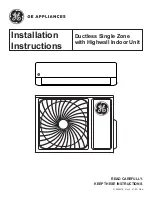
6 - 14
2WAY SYSTEM
Trouble Diagnosis
6
3. 2WAY Alarm Codes
F17 Alarm
Alarm code
F17
Alarm meaning
Low-pressure sensor trouble
Alarm conditions
(1) Sensor short circuit
(2) Sensor open circuit
Probable cause
(1) Sensor malfunction (including connector)
(2) The Outdoor Unit Control PCB malfunction
Check
(1) Measure the sensor resistance. Check that the sensor is operating normally.
Use a remote monitor or a PC monitor to check the temperature that is recognized
by the microcomputer.
(2)
Correction
—
—
—
—
—
—
Example
Notes
F31 Alarm
Alarm code
F31
Alarm meaning
Outdoor unit non-volatile memory (EEPROM) trouble
Alarm conditions
(1) Non-volatile memory is not present when power initialization occurs.
(2) Read values do not match after writing to non-volatile memory is complete.
Probable cause
(1) Memory was not inserted after the Outdoor Unit Control PCB was replaced.
(2) The lifetime of the non-volatile memory has been reached.
(3) Non-volatile memory is installed incorrectly (wrong direction, bent pins, etc.).
Check
(1) Check the non-volatile memory on the Outdoor Unit Control PCB.
Correction
Example
Notes
2WAY SYSTEM
Trouble Diagnosis
4. 2WAY Alarm Codes
(1) Wiring failure
(2) Power supply voltage malfunction (sudden-voltage-drop)
(2) Check the power supply voltage.
H01, H11 Alarm
Alarm code
Alarm meaning
Alarm conditions
Probable cause
Check
Correction
Example
Notes
H01, H11
H01: Compressor 1
current
trouble
H11: Compressor 2 current trouble
Compressor 1 (INV) or 2 (INV) primary current detected overcurrent higher than the values
(overcurrent) listed in the table below.
(1) Wiring failure
(2) Correct the power supply voltage.
(1) Wiring failure
—
—
Horsepower of unit
Current (A)
8HP
14.0
10HP
18.0
12HP
21.5
14HP
15.5
16HP
18.0
18HP
20.0
20HP
21.5
Forgot to connect the wires L1, L2, L3. Check whether the terminals are connected
correctly.
Correct the disconnection and wiring failure.
H03, H13 Alarm
2WAY SYSTEM
Trouble Diagnosis
4. 2WAY Alarm Codes
H05, H15 Alarm
Alarm code
H05, H15
Alarm meaning
H05 : Compressor 1 discharge temperature sensor disconnected
Alarm conditions
This alarm occurs when the discharge sensor temperature detector is not inserted into the tube’s
sensor holder, or when the sensor itself has suffered some kind of malfunction other than a cut
wire.
When outdoor air temperature is -10°C or higher:
Alarm occurs if the temperature detected by the discharge sensor has changed by less than
2°C when the compressor has operated for 10 minutes immediately after start.
When outdoor air temperature is below -10°C:
Alarm occurs if the temperature detected by the discharge sensor has changed by less than
2°C when the compressor has operated for 30 minutes immediately after start.
•
•
•
Probable cause
(2) Discharge sensor itself has suffered some kind of malfunction other than a cut wire.
Check
(1) Discharge sensor temperature detector is not inserted into the tube’s sensor holder.
(1) Check that the discharge temperature sensor is inserted into the sensor holder.
(2) Check that sufficient heat-conducting putty is applied.
(3) Remove the discharge sensor from the sensor holder and expose the sensor to the outside
air for approximately 5 minutes. Check that the temperature detected by the sensor changes
to match the outside air temperature. (However the sensor cannot detect temperatures at or
below 0 °C.)
Correction
(1) Install the sensor into the holder, and apply sufficient heat-conducting putty.
(2) If the sensor is malfunctioning, replace it.
Example
—
H15 : Compressor 2 discharge temperature sensor disconnected
Alarm code
H03, H13
Alarm meaning
H03 : Compressor 1 CT sensor disconnected or short-circuit
Alarm conditions
Compressor 1, 2: When the frequency of compressor (INV) is over 35Hz and the secondary current
is over 7.0A, the primary current detected lower than 0.7A.
* No current is detected even though the compressors are operating.
Probable cause
(2) HIC PCB failure
(3) Power supply and voltage malfunction
Check
(1) CT failure
Check the power supply and voltage. Check whether the voltage between each of the phases is
correct while the compressor is running.
(It is necessary to check the compressor while running because the voltage may decrease if the
compressor starts running.)
Correction
(1) Correct the power supply voltage.
(2) Replace HIC PCB.
Example
—
Notes
—
H13 : Compressor 2 CT sensor disconnected or short-circuit
SM830253-00_欧州2way7_SM-TRSM.indb 14
16/08/02 14:02:50
















































